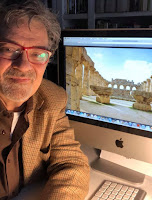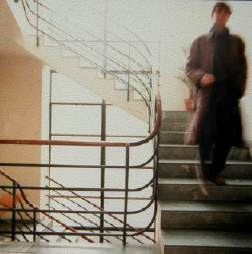A Paradigm Shift: The IT Revolution in Architecture
An Open-video-course
by prof. Antonino Saggio
“Sapienza" University of Rome
School of Architecture
Dept of Architecture and Design

The course presents a combination of theoretical and application aspects. The theoretical aspects concern relations between Information Technology and Architecture in this historical phase. The course takes place in about 30 modules of 35 minutes each. The classes are grouped into six thematic cycles that go from the "Introduction to the "World of the Web" to the "World of Rasters", "From the Vector Environment" to the"Creation of the world 3d" from "Spreadsheets and Databases" up to "Hierarchical structures and BIM". Each cycle offers lessons on the theoretical and software environments and on parallel developments in contemporary architectural research. At the end of each cycle, students draw up a specific practical and theoretical exercise that converges on the theme of the year. In this case "Unlost Territories Aniene Flows ".
Each class has a video of 35 minutes and a selection of images.
Click the links below
INAUGURAL CLASS:
0º Inaugural Class:
 Crisis Modernity and Information Technology
Crisis Modernity and Information Technology
PRIMO CICLO:
L'impatto dell'informatica nella città e nella ricerca architettonica contemporanea | Il World Wide Web
1º Class:
 A Definition of Information
A Definition of Information2º Class:
 The Native Scene of Architecture in the Age of Information
The Native Scene of Architecture in the Age of Information3º Class:
 The Role of Information in Contemporary Society
The Role of Information in Contemporary Society4º Class:
 Architecture in the Age of Information: The Return of the Rhetorical Figures
Architecture in the Age of Information: The Return of the Rhetorical Figures
5° Class:  The long crisis of XIX century
The long crisis of XIX century
 The long crisis of XIX century
The long crisis of XIX century
Questa lezione serve a dimostrare quanto sia stato lungo e complesso costruire un nuovo paradigma per l'architettura in risposta alla rivoluzione industriale. Arte, ingegneria, artigianato sono stati i diversi affluenti che hanno permesso di formare nuove idee. Ma un altro salto sarà necessario. Lo affronteremo nella prossima lezione dedicata all'edificio. del Bauhaus.
6º Class  Transparency: the Catalyst of the Architecture of the Industrial Revolution
Transparency: the Catalyst of the Architecture of the Industrial Revolution
The lesson is based on the concept of paradigm shift illustrated in the field of scientific thought by Thomas Kuhn. In the lesson it is argued that the "revolution of functionalist architecture" in the twenties of the twentieth century can be understood as a real paradigm leap compared to the previous one. A proof of this working hypothesis is a "chart" organized in six categories and that uses different keywords for the architecture of the "first wave" and "second wave". The concept of catalyst plays a decisive role.
La lezione si basa sul concetto di salto di paradigma illustrato nel campo del pensiero scientifico da Thomas Kuhn. Nella lezione si sostiene che la "rivoluzione dell'architettura funzionalista" negli anni Venti del Novecento piuò essere intesa come un vero e proprio salto di paradigma rispetto a quella precedente. A riprova di questo ipotesi di lavoro si usa un "chart" organizzato in sei categorie e che utilizza delle diverse parole chiave per l'architettura della "first wave" e della "second wave". Ruolo determinante è il concetto di catalizzatore.
7º Class  The HTML Revolution
The HTML Revolution
The lesson retraces the keywords needed to navigate the world of the Intenet: from IP to ISP, from HTM to FTP. The second part briefly illustrates the steps needed to create a website. It also focuses on the need for individual participation in the positive experience of the Internet. Be brave: learn!
La lezione ripercorre le parole chiave necessarie per orientarsi nel mondo della rete.; dall'IP allo ISP, dall'HTM all'FTP. Nella seconda parte illustra brevemente i passaggi necessari per creare un web site. Si sofferma anche sulla necessità della partecipazione individuale all'esperienza positiva di Internet. Sii coraggioso: impara!
SECONDO CICLO:
Il mondo dei pixel materialità e immaterialità |
Hardware e schermi, la digitalizzazione delle immagini. Il mondo raster.
8º Class  How Many Times? Short history of calculation from the Abacus to the iPad
How Many Times? Short history of calculation from the Abacus to the iPad
The Class was introduced to "Leonardo", i.e. the conceptual artifice that will follow all the other cycles of our course. We wonder .. How would Leonardo solve a specific problem without electricity, hardware software? This way to pose the question serves to underline the conceptual basis for each IT environment. We start with the world of raster, the invention of the grid an the quickdraw graphic screen revolution. The lesson illustrates the difference between Depth Resolution. It asks the production of a "Self-portrait at the time of the Coronavirus" produced with a raster program. By next Monday.
Alla Classe viene presentato “Leonardo”. E cioè l’artificio concettuale che seguirà tutte gli altri cicli didattici del nostro corso. Ci domandiamo .. “come avrebbe Leonardo a risolvere un problema specifico senza elettricità, software hardware?” Questo artificio comunicativo serve a sottolineare la base concettuale per ciascun ambiente informatico. incominciamo con il mondo del raster l’invenzione della griglia e/o la rivoluzione del sistema quickDraw. Nella lezione si illustra la differenza tra Risoluzione Profondità. Si chiede ancella produzione di “Autoritratto al tempo del Coronavirus” con un programma raster, per il prossimo lunedì.
10º Class  A Bit World: The Return of Surface in Architecture.
A Bit World: The Return of Surface in Architecture.
TERZO CICLO:
La stratificazione e le sovrapposizioni | Il Mondo dei vettori. Geometrie e layer.
12° Class  A Vector World
A Vector World
 A Vector World
A Vector World
13º Class  With layers, a difference arrives
With layers, a difference arrives
 With layers, a difference arrives
With layers, a difference arrives
The class discusses the arrival of layers. It is an important combination of the semantic and geometric level allowed by the vector environment. Immediately, thinking through the layers, important functional advancements are realized, but progressively it is understood that the advancements are also of a design type: a divers world can be born. To demonstrate this thesis, a short journey is made through three works and three personalities. "The lighting field" by Walter De Maria, "The Cannaregio project" by Peter Eisenman and ""he Parc de La Villette" project by Bernard Tschumi. You will see that the great acquisition of the world of layers is the independence of each. Each layer can be optimized according to its specific needs. The combination of the various layers leads to a more efficient and rich world. The old unitary world can no longer be recomposed.
La classe discute dell'arrivo dei layer. E una importante combinazione del livello Semantico e geometrico permesso dall'ambiente vettoriale. Immediatamente, pensando attraverso i layer, si realizzano importanti avanzamenti funzionali, ma progressivamente si comprende che gli avanzamenti sono anche di tipo progettuale: un mondo diverso può nascere. Per dimostrare questa tesi si compie un breve percorso attraverso tre opere e tre personalità. Il lighting field di Walter De Maria, il progetto di Cannaregio di Peter Eisenman e il progetto del Parc de La villette di Bernard Tschumi. si vedrà che la grande acquisizione del mondo dei layer è la indipendenza di ciascuno. Ogni layer può essere ottimizzato in ragione delle sue specifiche necessità. La combinazione tra i vari layer portanto ad un mondo più efficiente e ricco. Il vecchio mondo unitario non può più essere ricomposto.
14º Class  Peter Vector Eisenman
Peter Vector Eisenman
 Peter Vector Eisenman
Peter Vector Eisenman
QUARTO CICLO:
Masse, collisioni, traiettorie | La creazione della tridimensionalità. Estrusioni, Rotazioni, Operazioni booleane
16º Class:  A «True» 3D World Arrives
A «True» 3D World Arrives
 A «True» 3D World Arrives
A «True» 3D World Arrives
17º Class:  Time, First Dimension of Space
Time, First Dimension of Space
 Time, First Dimension of Space
Time, First Dimension of Space
18º Class:  Frank ThreeD Gehry
Frank ThreeD Gehry
 Frank ThreeD Gehry
Frank ThreeD Gehry
QUINTO CICLO:
L'organizzazione delle informazioni in Modelli | Lo Spreadsheet, il Data-base
19º Class: A New Thinking. The "What If?" Arrives
SESTO CICLO:
I progetti della modificazione | Interconnessioni dinamiche. Strutture gerarchiche e modelli intelligenti
Classes Have Been Transmitted by Antonino Saggio FaceBook
every Monday and Thursday from March to June 2020
Originally intended for FB friends around the world, they have been followed formally by a group of Students of Sapienza.
Originally intended for FB friends around the world, they have been followed formally by a group of Students of Sapienza.
6:00 pm Rome time
12:00 noon Eastern time
9:00 am Western time






























No comments:
Post a Comment